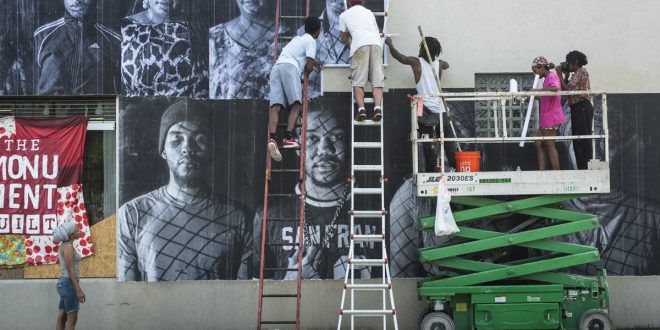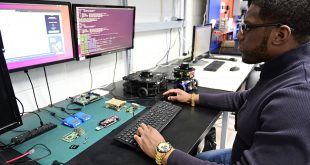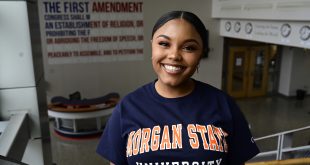Black lives matter. And one Morgan professor took up the challenge to show the world just how much.
More than a year ago, Chris Metzger, a professor in Morgan State University’s Visual Arts Department, asked his students to join him in a public art project to raise social awareness. The project would be in direct response to a call to action from French street artist JR, who challenged the world’s art community and others to “stand up for what you care about” and “turn the world inside out” by changing it.
“The function of art is to make that understood which in the form of argument would be incomprehensible.” ~ Constantin Brancusi
JR’s movement became the “Inside Out” project – a worldwide initiative spurring people to advocate for what they believe in through the use of enormous portraits that make a statement on the exterior of buildings. Inside Out quickly became a global platform for people to share their untold stories and transform messages of personal identity into works of public art. Since 2011, nearly 200,000 people from more than 112 countries and territories have participated. This past June, professor Metzger and his students added to that number. For Morgan, this project marks the first large-scale public art piece of its kind.
“The aim of our involvement as a university is to shed light on the presence of invisible boundaries and limitations placed on black people throughout different facets of our lives,” said Metzger. “By participating in the Inside Out Project, we are joining hundreds of thousands of others from around the world in using art to stand up for a cause we feel passionate about.”
While professor Metzger was the one who initially organized Morgan’s participation in the project, it has been a true collaborative process with students involved every step of the way. It was the students that proposed and selected the project’s “Black Lives Matter” theme. Started in 2012, after the murder of Trayvon Martin, the Black Lives Matter Movement, according to its website, became a “call to action and a response to the virulent anti-black racism that permeates our society.”
Their input is also displayed in the project’s artistic direction. The group utilized black and white photography but also made a decision to cast a fence shadow on each of the subjects, symbolizing the presence of invisible boundaries and limitations placed on black people throughout different aspects of their daily lives. They felt this added an interesting layer of emotion to the images.
Operating within a studio space, students shot portraits of themselves and other people they came in contact with. The portraits were developed and later meticulously wheat-pasted at the site of their outdoor canvas. Creatively, the outcome, which took Metzger and his team of students three 12-hour days to install, can easily be described as compelling. In total, 42 portraits were taken and more than 40 combined university students, faculty and staff lent a hand to the project.
 Today, at 1400 Greenmount Avenue, just a few blocks from Baltimore’s Penn Station, on the façade of a building that later this year will house Open Works – an incubator space for Baltimore’s creative community – stands a wall adorned with black faces, many of which are Morgan State University students. The group hopes the artwork can remain on the building for all to see until work begins on the new Open Works facility perhaps this fall. There also will be artwork featured at a second location – a police sub-station, or kōban, on the corner of Charles Street and Falls Road.
Today, at 1400 Greenmount Avenue, just a few blocks from Baltimore’s Penn Station, on the façade of a building that later this year will house Open Works – an incubator space for Baltimore’s creative community – stands a wall adorned with black faces, many of which are Morgan State University students. The group hopes the artwork can remain on the building for all to see until work begins on the new Open Works facility perhaps this fall. There also will be artwork featured at a second location – a police sub-station, or kōban, on the corner of Charles Street and Falls Road.
“At the project’s conception we had no idea the events that would soon unfold in Baltimore following the death of Freddie Gray; however, our project seems even more relevant today than when we first began,” added Metzger. “Although saddened and disturbed by the continued use of deadly force by police, we are hopeful that our project adds to the growing awareness of police brutality and the value of black life, locally and nationally.”
Professor Metzger encourages everyone to view the Morgan State University “Black Lives Matter: Inside Out Project” in person because he believes words cannot properly convey the impact of seeing it firsthand. Given the large size format of each image, they may be hard to miss by passersby and so are the stories etched in each of the faces represented. Each one of the black lives represented in those images is different. And each one matters.
_____________________
For more information on the project, visit:
http://www.christophermetzger.com/black-lives-matter-inside-out-project/
http://www.christophermetzger.com/blog/2015/6/22/morgan-state-inside-out-project-installation
 Morgan State University Newsroom Morgan State University
Morgan State University Newsroom Morgan State University





